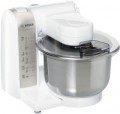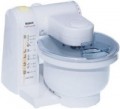Power
Rated power of the food processor. Most of this power comes from the engine — the rest of the unit consumes very little energy. Usually, the
more power, the higher the productivity of the unit, and the less time it takes to process products.
Note that the optimal power value directly depends on the volume of the bowl (see the relevant paragraph): for example, for a 1.5 kg bowl, at least 300 W is desirable, for a two-kilogram bowl — 400 W, a three-kilogram bowl — at least 700 W. And with the same bowl capacity, a more powerful unit will be more productive, it will work faster and better cope with high loads (for example, a full load). On the other hand, an increase in power affects energy consumption and price.
Max. revolutions
The maximum speed of rotation of the working attachment of the food processor. The higher the rotation speed, the more solid products can be processed in a food processor, and the less (in some cases) the time to complete the desired procedure.
Main bowl material
The bowls of modern food processors can be made of plastic, glass, or metal.
The plastic bowls are the most common due to their low cost and durability. They are lightweight, resistant to falls and can withstand quite large loads, they can be both transparent and opaque. The disadvantage of plastic is an increased tendency to scratches.
The glass bowls are scratch-resistant, and they allow you to monitor the products processing through transparency. However, the glass is a fragile material, and such bowls are very sensitive to falls, shaking, and bumps.
Metal (usually stainless steel) is the strongest and most durable material. However, it is opaque, in addition, the
metal bowl usually significantly affects the cost of the device.

